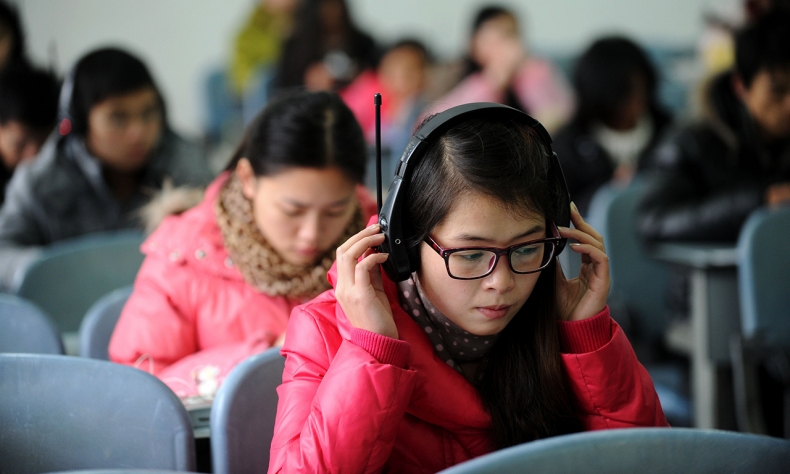
English Language Education in China: Initiation, Innovation, and Integration
Foreign languages education in China has played important educational and social functions, especially following the rapid opening of society in recent decades.
In December, China’s Standards of English Language Ability (CSE) was successfully linked to the TOEFL iBT. This change now allows the alignment of the scores for Reading, Listening, Speaking and Writing, which are the four main sections in the TOEFL, with the corresponding CSE levels. According to some observers, this collaboration is significant in that it will enhance the international influence of the CSE, and promote the connection of global educational technology standards. More importantly, the arrangement helps Chinese students, schools and test takers better understand the requirements of international standardized examinations, and boosts the opening and development of China’s foreign languages education.
Foreign languages education in China has played important educational and social functions, especially following the rapid opening of society in recent decades. Efforts to include English in the Chinese curriculum can be dated back to the 1950s, at a time when Russian was more popular in schools, and the purpose of teaching foreign languages was mainly for translation. Around ten years later, English has gradually supplanted Russian as a subject in secondary school teaching. Since then, the status of English in the curriculum has been officially established, valued, and even prioritized.
In many provinces, English has an essential place in the college entrance examination (gaokao). It is estimated that there are around 400 million people in China learning English, accounting for one-third of the total population. In 2018, according to the Center for China and Globalization, the number of TOEFL test takers reached 300,000, ranking first in the world.
Admittedly, compared with the 1960s, the functions of English today have been played down, given the rising importance of the Chinese language in international communications. However, the core of English education has remained almost unchanged, highlighting grammar as the key to language excellence. Therefore, for Chinese learning English, and students in particular, English is still more of a “hard knowledge” subject rather than a “soft” conversational skill, which is clearly reflected through their TOEFL scores – most Chinese test takers actually perform satisfactorily in reading comprehension, but are weaker in listening and speaking.
Unsurprisingly, it was not until 1981 when the TOEFL was first introduced into China that listening comprehension made its debut in Chinese students’ test papers. In the following years, learners gradually adapted to the international standardized examination and are now becoming more skillful in the English language. The 38 years after the TOEFL was first introduced not only witnessed the growing popularity of English and the TOEFL, but also the innovation, development, and challenges of English language education in China.
China’s Standards of English Language Ability (CSE) is a good case in point. The formulation and release of such a unified language proficiency scale allows English language education in China to be more scientific, transparent, and fair. Based on the theory of communicative language competence, the CSE can distinguish nine proficiency levels in listening, speaking, reading and writing for all levels of English learners – from elementary school to university in China. In other words, all Chinese students’ ability in English can be described and assessed by a unified national standard through the CSE, which helps to promote education equality in China.
With the increasing international exposure that Chinese people and students are receiving now, the cooperation and integration between the CSE and TOEFL indicate China’s ambition and capability to innovate on its foreign languages education system. Through this it is clear that China intends to cultivate and equip talents with an international vision, higher proficiency in English and knowledge of international norms and rules. In addition, the integration largely relieves the economic burden caused by the TOEFL fees, which may encourage more students to study abroad. This could in turn ease domestic competition to some degree.
On the other hand, the parameters that the CSE adopts might still need further experimentation, especially in terms of how the CSE could work with the actual teaching conducted in schools for English teachers. Also, despite the collaboration between the CSE and TOEFL, can the CSE, a set of standards that are designed locally, eventually replace standardized exams such as the TOEFL, IETLS, and PTE? Alternatively, besides having a competitive relationship, can the different exams form a collaborative framework to create a fairer and more transparent way of assessing language learners’ ability across the board?
Needless to say, despite all prospects and uncertainties, it is still necessary for the English language education in China to continuously reform and innovate as well as to take on and surmount future challenges. More efforts are thus needed toward this end.
Mathew Wong is an assistant professor in the Department of Social Sciences at the Education University of Hong Kong.
Source: china.org.cn
 Facebook
Facebook
 Twitter
Twitter
 Linkedin
Linkedin
 Google +
Google +










